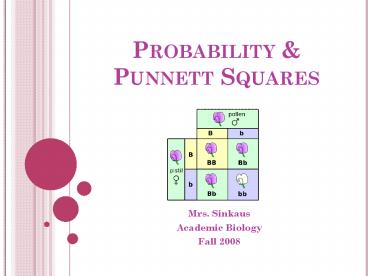Probability PowerPoint PPT Presentation
1 / 20
Title: Probability
1
Probability Punnett Squares
- Mrs. Sinkaus
- Academic Biology
- Fall 2008
2
Bell Ringer
What do these pictures show? What is unusual
about this hand and foot? Look closely!!
3
Bell Ringer cont.
- The hand and foot have six fingers and toes
instead of five. - This is the result of a genetic disorder referred
to as Polydactyly having more than five digits.
4
Bell Ringer cont.
What religious group do these people belong to?
They are Amish - lead a simple life centered on
family and religion. Large population resides in
Lancaster County, PA.
5
Bell Ringer Cont.
The Amish live separately from the rest of
society. They typically marry only other Amish
people. What if I told you Polydactyly is more
common among the Amish than in the general
population. Why do you think that is true?
Why might it someday be important for you to know
if you are a carrier for a genetic disease?
6
Objectives
- As a result of this lesson you (my students)
- will be able to
- Explain how geneticists use the principles of
probability - Describe how geneticists use Punnet Squares
- Distinguish between the concepts heterozygous and
homozygous - Solve genetic problems using a Punnet Square
- Explain the difference between probable genotypic
and phenotypic ratios and actual numbers of
offspring
This lesson will address Science and Technology
PA Standards 3.3.10C, and 3.2.10C,D
7
What is Probability?
Probability is the likelihood that a particular
event will occur Example A coin flip What are
the possible outcomes when you flip a
coin? Answer There are two it could land
heads up or tails up
8
What is Probability? Cont.
Probability is the likelihood that a particular
event will occur Example A coin flip What are
the chances a coin will land heads up? Answer
50 or ½ What are the chances a coin will land
tails up? Answer 50 or ½
9
What is Probability? Cont.
- If you flip a coin 3 times in a row, what is the
probability it will land heads up - every time?
- Each coin flip is an
- independent event each time the coin is
flipped, the probability of it landing heads up
is ½ . - The probability of flipping 3 heads in a row is
- ½ x ½ x ½ 1/8
- Remember Past outcomes do not effect future
outcomes!
10
How does Probability relate to Genetics?
- The principles of probability can be used to
predict the outcomes of genetic crosses! - Coin Toss Lab
- Work with a partner
- Click here to practice your probability skills
- Follow the instructions on this worksheet to
complete the Coin Toss Lab
11
Coin Toss Lab Discussion
- Did your results equal your calculated
probabilities? - What did you notice as your number of tosses
increased? - Answer The more times you tossed your coin, the
closer your actual results should have been to
your predicted probability. - Probable outcomes are not always equal to actual
outcomes however, the two should get closer as
the number of trials increases.
12
Homework Review
- When an organism has two identical alleles for a
particular trait (ex. TT or tt), it is said to be
_______. - Answer Homozygous
- When an organism has two different alleles for
the same trait (ex. Tt), it is said to be
_________. - Answer Heterozygous
13
Homework Review cont.
- This girl is displaying one of the traits from
- your homework which one?
- Answer Widows Peak
- What is her phenotype?
- Answer She has a Widows Peak
- What is a possible genotype given that Widows
Peak is a dominant allele? - Answer AA or Aa
14
Interactive Activity
- Click here to practice your knowledge of genotype
and phenotype in this web lab!
15
Punnett Squares
- Lets combine our knowledge of probability with
our understanding of genotype and phenotype. - Click on the Punnett Square above to learn how to
use Punnett Squares to predict the genotypes and
phenotypes of offspring given the parents
genotypes!
16
More Punnett Squares!
- Work with a partner to complete this web lab on
Punnett Squares. - Click on the rooster below to enter the web lab!
17
Closure
- Lets return to our Bell Ringer
- What is the genetic disorder that is displayed in
this picture? - Answer Polydactyly
- Polydactyly is a dominant genetic
- disorder. John is heterozygous for
- Polydactyly What is his genotype?
- Answer Pp
- What is Johns phenotype?
- Answer He displays the symptoms of the disorder
he has six toes.
18
Closure cont.
- John (Pp) marries Diane who is homozygous for
Polydactyly. What are the chances they will have
a child who is homozygous for Polydactyly? - Use a Punnett Square to answer the question!
19
Closure cont.
- Answer 2/4 or 50
- P p
P P
20
Homework
- Click on Sponge Bob for a worksheet on
- Bikini Bottom Genetics for more Punnett Square
practice!

